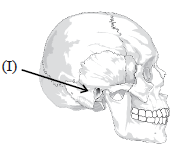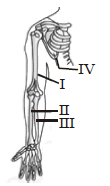Please see Chapter 20 Locomotion and Movement Exam Questions Class 11 Biology below. These important questions with solutions have been prepared based on the latest examination guidelines and syllabus issued by CBSE, NCERT, and KVS. We have provided Class 11 Biology Exam Questions and answers for all chapters in your NCERT Book for Class 11 Biology. These solved problems for The Living World in Class 11 Biology will help you to score more marks in upcoming examinations.
Exam Questions Chapter 20 Locomotion and Movement Class 11 Biology
Objective Questions
Question. The axon terminals of a nerve cell and the sarcolemma of a skeletal muscle cell join at the_______
(a) motor unit
(b) synaptic cleft
(c) action potential
(d) neuromuscular junction
Answer
D
Question. Hyoid bone is located
(a) at the top of the buccal cavity.
(b) at the floor of the buccal cavity.
(c) in front of the skull.
(d) behind the skull.
Answer
B
Question. Which of the following is not part of axial skeleton?
(a) Sacrum
(b) Sternum
(c) Mandible
(d) Humerus
Answer
D
Question. Part of the body having a single pair of bones is called
(a) pelvic girdle
(b) external ear
(c) wrist
(d) lower jaw
Answer
A
Question. Glenoid cavity is found in
(a) pelvic girdle
(b) skull
(c) pectoral girdle
(d) sternum
Answer
C
Question. Number of floating ribs in human body is
(a) two pairs
(b) three pairs
(c) five pairs
(d) six pairs
Answer
A
Question. Elbow joint is an example of
(a) hinge joint
(b) gliding joint
(c) ball and socket joint
(d) pivot joint
Answer
A
Question. An example of gliding joint is
(a) humerus and glenoid cavity
(b) femur and tibio-fibula
(c) occipital condyle and odontoid process
(d) zygapophyses of adjacent vertebrae
Answer
D
Question. The joint in our neck which allows us to rotate our head left to right is
(a) pivot joint
(b) hinge joint
(c) saddle joint
(d) ellipsoid joint
Answer
A
Question. Which of the following is an autoimmune disorder ?
(a) Myasthenia gravis
(b) Osteoporosis
(c) Muscular dystrophy
(d) Gout
Answer
A
Statement Type Questions
Question. Which of the following is not the feature of red muscle fibres?
(a) They have plenty of mitochondria.
(b) They have high content of myoglobin.
(c) They have high amount of sarcoplasmic reticulum.
(d) They are called aerobic muscles.
Answer
C
Question. Which of the following statement is correct?
(a) All striated muscles are voluntary.
(b) Visceral muscles are faintly striated.
(c) Cardiac muscles are not striated.
(d) All non-striated muscles are involuntary.
Answer
D
Question. During muscle contraction.
(a) chemical energy is changed to electrical energy.
(b) mechanical energy is changed to chemical energy.
(c) chemical energy is changed to physical energy.
(d) chemical energy is changed to mechanical energy.
Answer
D
Question. Which one of the following is the correct description of certain part of a normal human skeleton?
(a) Parietal bone and the temporal bone of the skull are joined by fibrous joint.
(b) First vertebra is axis which articulates with the occipital condyles.
(c) The 9th and 10th pairs of ribs are called the floating ribs.
(d) Glenoid cavity is a depression to which the thigh bone articulates.
Answer
A
Question. Select the correct statement with respect to locomotion in humans.
(a) Accumulation of uric acid crystals in joints causes their inflammation.
(b) The vertebral column has 10 thoracic vertebrae.
(c) The joint between adjacent vertebrae is a fibrous joint.
(d) The decreased level of progesterone causes osteoporosis in old people.
Answer
A
Question. According to the sliding filament theory of muscle contraction,
(a) actin binds ATP and breaks it apart as actin pulls against myosin.
(b) calcium ions are released from myosin as the filaments slide by.
(c) the thick and thin filaments do not change length during this process.
(d) all of the above
Answer
C
Assertion/Reason Type Questions
In the following questions, a statement of Assertion is followed by a statement of Reason.
(a) If both Assertion and Reason are true and the Reason is the correct explanation of the Assertion.
(b) If both Assertion and Reason are true but the Reason is not the correct explanation of the Assertion.
(c) If Assertion is true but Reason is false.
(d) If both Assertion and Reason are false.
Question. Assertion-: Knee joint is an example of hinge joint.
Reason : Femur, patella and fibula are associated with knee joint.
Answer
D
Question. Assertion : Recurrent activation of the muscles will become fatigue.
Reason : Anaerobic breakdown of glycogen in the muscles can lead to the accumulation of lactic acid.
Answer
A
Question. Assertion : Ball and socket joints are the most mobile joints.
Reason : Synovial fluid is present here.
Answer
B
Matching Type Questions
Question. Three of the following pairs of the human skeletal parts are correctly matched with their respective inclusive skeletal category and one pair is not matched. Identify the non-matching pair.
Pairs of skeletal -parts Category
(a) Sternum and ribs – Axial skeleton
(b) Clavicle and glenoid – Pelvic girdle cavity
(c) Humerus and ulna – Appendicular skeleton
(d) Malleus and stapes – Ear ossicles
Answer
B
Question. Which of the following pairs of joints and its location is correctly matched?
(a) Hinge joint – Between vertebrae
(b) Gliding joint – Between zygapophyses of the successive vertebrae
(c) Cartilaginous joint– Skull bones
(d) Fibrous joint – Between phalanges
Answer
B
Question. Match column I (types of synovial joints) with column II (bones involved) and choose the correct option.
| Column I (Type of synovial joint) | Column II (Bone involved) |
| A. Ball and Socket joint | I. Carpal and metacarpal of thumb |
| B. Hinge joint | II. Humerus and pectoral girdle |
| C. Pivot joint | III. Knee |
| D. Saddle joint | IV. Atlas and axis |
(a) A – I; B – II; C – III; D – IV
(b) A – II; B – III; C – IV; D – I
(c) A – III; B – I; C – IV; D – II
(d) A – IV; B – III; C – II; D – I
Answer
B
Question. Which of the following functional characteristics of muscle is correctly matched with its appropriate descriptive term?
I. Elasticity- Ability of a muscle fibre to recoil and resume its resting length after being stretched.
II. Excitability- Ability to respond to any change in the environment (inside or outside the body)
III. Extensibility- Ability to be stretched
IV. Contractility- Ability to shorten forcibly when adequately stimulated
(a) I and III only
(b) II and IV only
(c) I, II, and III only
(d) All of these
Answer
D
64. Match the column I with column II and select the correct option.
| Column-I | Column-II |
| A. Striated appearance of myofibril | I. Distribution pattern of actin and myosin |
| B. Store house of calcium ions | II. Sarcoplasmic reticulum |
| C. Energy released from ATP hydrolysis | III. Helps myosin head to bind to exposed active sites on actin to form a cross bridge |
| D. Globular head of meromyosin | IV. Active ATPase enzyme and has binding sites for ATP and active sites for actin. |
A B C D
(a) I II III IV
(b) III I IV II
(c) II I III IV
(d) III IV II I
Answer
A
Diagram Type Questions
Question. In the given diagram of skull, what does “I” represent?

(a) Frontal bone
(b) Temporal bone
(c) Occipital bone
(d) Parietal bone
Answer
B
Question. The given diagram of human skeleton system shows types of ball and socket joint. Identify the joints which are marked as I, II, III, IV and V

(a) I and II
(b) II and IV
(c) III and IV
(d) IV and V
Answer
B
Question. Which two bones in the given figure form a hinge joint?

(a) I and II
(b) I and III
(c) I and IV
(d) II and III
Answer
B